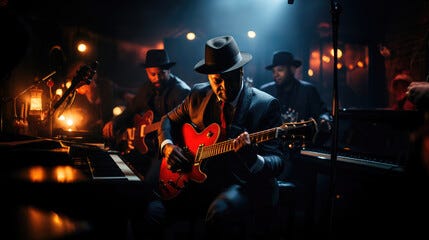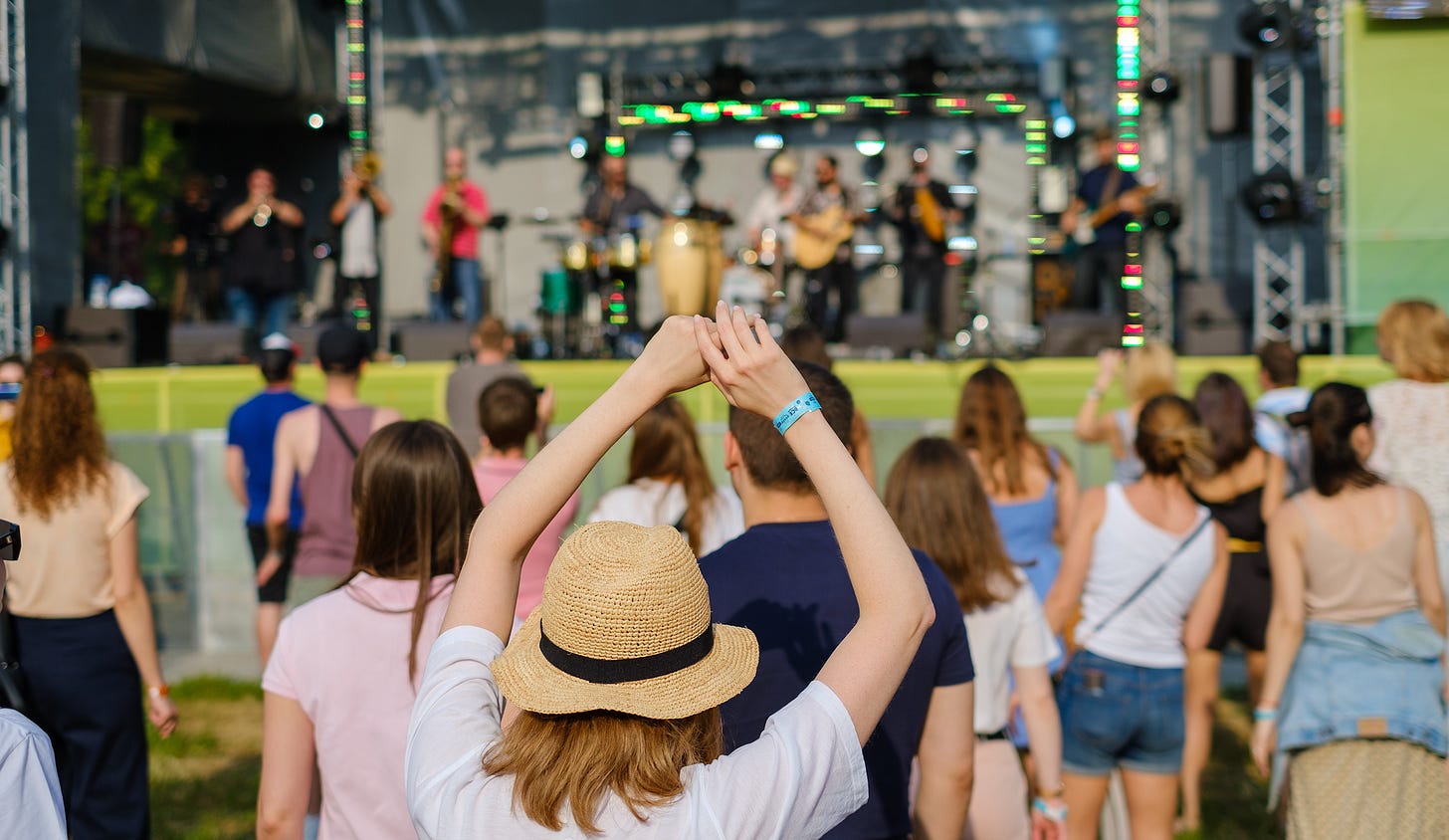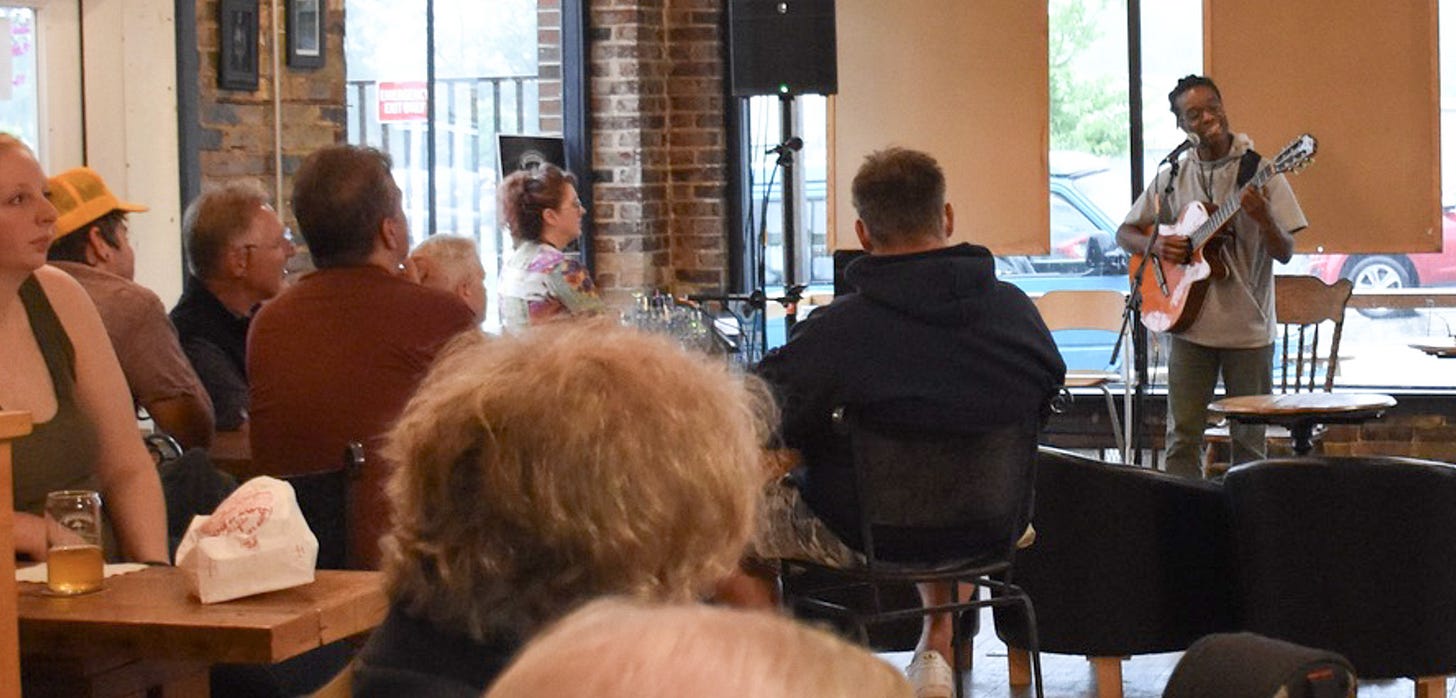Audience Engagement as Harassment in Music Performance?
The "E" in PERMA Part 2: Defining Musical Engagement
A few weeks ago I attended a house concert featuring a guitar duo in a beautiful, bright attic with a high ceiling. Approximately eighty listeners sat in mismatched, yet organized and comfortable seating, facing a small, but sufficient, homemade stage. Iconic relics representing the development of 20th century music lined the walls of the stairway leading to the performance room which was also surrounded by walls and shelves filled with instruments, radios, audio recording equipment, books, albums, phonographs, concert posters representing music of the last hundred years. Even music education was represented by a small set of marching percussion sitting high up above the entry door. Every detail served to help the listener separate themselves from the ordinary, every day mental clutter as they entered a space for listening and engaging in the presented musical experience.
Sitting on a bench backed up to the control room window, I sat shoulder to shoulder between my friend and another woman whom I didn’t know. During the last few tunes of the night, the unknown woman began dancing in her seat as a friend seated in front of her recorded a video for social media. My attention drifted away from the aesthetics of the decor and the beautiful guitar performance, and shifted instead to protecting myself from being bumped by various body parts approximately every other beat as I was simultaneously ducking to avoid being in a social media post.
Even in the awkwardness, part of me was celebrating this example of successful musical engagement between the musicians and an audience member. However, I also wondered if she was genuinely engaged, or if perhaps she was just putting on her own performance for social media. We were in a tightly packed room with no one else dancing. I questioned what would constitute appropriate concert etiquette for this particular setting involving a guitar duet playing jazz, chorro, and popular music in a gypsy style for a moderately sized, but crowded audience in an intimate house setting. Consequently, I wondered if musical engagement has a separate set of rules from what we typically consider as concert etiquette, and at what point does musical engagement become musical harassment?
My recent bumpety-bump experience at the guitar duo house concert is just one example of social-cultural issues in an evolving field of music performance. In my introductory article on this subject “Engaging Audiences in Music Performance” I propose a model in Positive Psychology for understanding social flow as a high level of audience engagement in music performance. Pavle Marinkovic, writer of the Substack Sound Awareness, questioned the usefulness of planned musical engagement in live performance (see below for his comment). He brings up a valid point that sometimes audience engagement initiated by performers can feel forced or uncomfortable by some in the audience. As the introverted, quiet, and contemplative audience member sitting next to the dancing queen, I can definitely relate to Marinkovic’s point of view (see his comment below).
However, Marinkovic is likely referring to when a musician asks the audience to participate by singing, clapping, or participating in a call and response, all having the potential to feel forced to an audience member not ready or willing to engage. Though the listener is not forced to participate, it does change the experience for the contemplative listener, and some may even feel put upon, or even harassed as having paid equally for their seat and experience.
Marinkovic also refers to another type of engagement in the “genuine meet and greet” with audience members before and after a concert. I consider this type of pre and post concert activity as part of building “Relationships” that can lead to higher levels of musical engagement (of which will be highlighted as the “R” in PERMA in my future articles), but I haven’t considered social introductions in and of themselves as “musical engagement”. There appears to be multiple, individually constructed ideas of what constitutes audience engagement, as well as what types of musical engagement lie within the social acceptance parameters of concert etiquette.
Applause, possibly the most common and recognizable indicator of audience engagement in musical performance, but because etiquette dictates when applause will happen, applause can often be superficial or perfunctory rather than a true indicator of genuine audience engagement. Etiquette varies significantly by genre, cultural context, musical characteristics, and performance venues. Here I will attempt to tease out some perceptions of musical engagement etiquette by genre and venue, and developing contradictions as music continues to evolve.
Engagement in Musical Performance by Genre
Classical music (used here to reference Western or non-Western art music) is traditionally performed in formal settings such as concert halls where audiences are expected to remain quiet and focused until the end of a piece when proper etiquette calls for applause, usually controlled enthusiasm and a few energetic shouts of praise. When classical music is created by chamber groups and performed in smaller venues such as a house concert or event hall, etiquette may depend on the role of the music either as the focus of the event or as background music for the event. Classical music performed outdoors may have a more casual and relaxed approach to applause with louder cheers being acceptable, however, applause is sometimes understated as concertgoers are entertained by other activities such as picnicking and socializing.
Rock and other popular genres perform in a wider variety of concert venues with an informal atmosphere that encourages audience enthusiasm through singing, cheering, clapping, and dancing. An exchange of energy among musicians and listeners often includes interactions such as sing-alongs, call and response, and inviting fans on stage.
Jazz involves improvisation and other interactions among band members. In addition to applauding after each piece, etiquette for jazz audiences often includes applause after each improvised solo. The connection between the audience and jazz musicians can come from intimate settings in small venues where a listener can be on the same level as, and even right next to a musician. However, jazz is also performed in the same large concert halls as classical music and the same outdoor festival stages as rock and other popular musics.
Electronic dance music and other dance music genres engage audiences through movement encouraging a social listening experience. Visual elements such as lights and projections engage audiences while fewer regular breaks contributes to a sense of continuous performance flow. Applause may occur after sets rather than individual songs, but it is also common to show appreciation for specific events by the DJ or musicians throughout a performance. In this genre, movement and dancing are considered a form of applause for demonstrating the audience’s approval.
Folk and world musics unite listeners through referencing cultural traditions that evoke a sense of identity and community. Listener participation may include clapping, singing, and dancing along with the musicians after which such an event applause would be expected. Storytelling through folk music creates a sense of connection among performers and listeners through the sharing of similar narratives, and an expectation of a more subdued and attentive audience takes over.
Engagement in Musical Performance by Venue
In addition to genre, audience engagement etiquette is also dictated by venue with formal settings having a stricter etiquette than informal settings. In concert halls we limit our reactions to what is socially appropriate which includes applauding even if we don’t feel like it, and not applauding sometimes if we do feel like it.
In restaurants, coffee shops, and pubs, however, even during live music events, audiences are eating, drinking, talking, and going about doing what one typically does at such establishments and may not engage with the music at all. I have had several audience members ask me during open mic nights and afternoon live music sets at breweries why others were talking during these performances. In some situations they leave because they are so upset by the experience…more potential for musical engagement harassment.
I recently received this message from Hana Stepanek, an open mic night participant, reflecting on the experience from a musician’s point of view (used with permission):
It was a special night for me, the "atmosphere" in the room was just right, the people were paying attention, and I felt good about performing. I went there another time and it was nothing like the first time. Many times people eat, talk, and do not pay attention to performers no matter how good they are (I think).
In eating and drinking establishments the rules are less clear with varying, and sometimes clashing, opinions. Here listener etiquette is influenced by the varying musical genres being presented, the background experiences and differing expectations of individual patrons, and the concerns of business owners to keep customers happy. Some establishment owners/managers have an expectation for musicians to control their sound level in order to stay in the background behind what the manager/owners consider as the more important, non-music related socializing.
Should traditional/formal concert etiquette be expected for music played in a pub or restaurant? Even with my formal training I don’t understand the expectations of others for formal etiquette in drinking and eating establishments. What about outdoor concerts? Are there different rules for the restaurant/pub if the music is outside? Or should orchestras allow drinks and food in the concert hall while encouraging audience responses such as clapping at any time during a performance? Does the genre or venue determine the etiquette? What are your thoughts on the following?
If an orchestra in a concert hall plays a piece in a jazz style with an improvised solo then should the audience clap after the solo?
When is applause or more involved musical engagement acceptable if an orchestra in a concert hall is performing a pops concert with a rock group?
If a classical guitarist plays a multiple movement dance suite at an open mic in a coffee shop, should the audience hold their applause until after the last movement?
What if the classical guitarist performed the same dance suite in a pub? Concert hall? Church?
I don’t have these answers as our culture as a whole will determine the music performance etiquette of the future while individuals set their own rules for now. However, I do know that I am uncomfortable both in informal and formal concert settings when the applause and cheering seem directed or inauthentic. I have observed bartenders initiating the applause for musicians who are not engaging an audience, as I have also experienced the overzealous and unearned shouting, whooping, and clapping by friends, family, colleagues, and/or stage managers for musicians in a concert hall, even when they have not yet played a note.
Shouldn’t audience appreciation be earned? When audience and musician are separated by space and other perceived barriers, and applause is scripted rather than offered, an inauthentic relationship exists that provides very little feedback to the musician on their effectiveness to communicate and connect with an audience.
These engagement etiquette generalizations vary also by individual performance, based on the preferences of the musicians, audiences, venue owners and managers, organization directors and managers, and creative directors (to name just some of the people involved). Additionally, the evolving nature of music means that new genres and hybrid forms continue to emerge, further diversifying (and confusing) the concept of “proper” audience engagement etiquette.
I question the idea that the venue, setting, or genre should dictate how one engages personally with music. The constraints of concert etiquette in formal settings may contribute to a sense of inauthenticity of audience reaction by both audiences and musicians due to audience responses being controlled and dictated. Such inauthentic experiences can contribute to anxiety which is widespread in classical music.
Professional arts organizations have been slowly addressing the evolving issue of relevance between social culture and the concert experience. One example is how Aubrey Bergauer, formerly the Executive Director of the California Symphony, redefined the classical concert experience by inviting listeners to bring drinks to their seats, use their phones on silent, and applaud whenever they feel like it. You can read about the implementation of her ideas in the article “Shaking Up the Symphony”. She also has a book coming out February, 2024, on managing arts organizations called Run It Like A Business.
College students are also active in creating performance opportunities with enriched opportunity for engagement and their own style of performance etiquette. Samuel Tolbert, President of the Black Schwob Society at Columbus State University shared with me the following on his development of a student led performance series:
A move towards a more comfortable environment for music making and listening at first sounds appealing, however etiquette functions to protect the listener’s experience from a feeling of harassment, whether that be the person bumping into you as they dance beside you, spilling their drink on you as they applaud, or interrupting your listening experience while using their phone or cheering. A common guideline for engagement at live concerts is to be attentive to the atmosphere and align applause and other activity with the cultural and social norms of that particular setting. However, does such a generic guideline leave open the establishment of cultural norms by those with the loudest voices?
To repeat the words of positive psychologist Christopher Peterson again:
Other people matter.
It matters that those attending a concert can all enjoy the performance experience, though pleasing everyone is rarely a possibility. As a musician, first consider how to present yourself authentically, as this is ultimately what you can control.
Consider the following:
What is important and meaningful to you? How might you make music in a way that helps you find meaning and pursue your life’s purpose?
How might you make music and perform in a way that connects you to your personal strengths and values? See the “Music Performance Anxiety - First Embrace Your Strengths” article for identifying your personal strengths.
Perhaps it comes down to this:
Do you want to engage your audience, and does your audience want to be engaged?
If your answer is “yes” to both, then the next question is:
“What does music engagement look like to you, and how do you create a meaningful engagement experience for your audience?”
Bill’s Thoughts…
I still remember as a seven-year-old my father taking me to see the opera “The Girl of the Golden West” by Giocomo Pucinni. Even as a kid, I was riveted by both the music and the action on stage. I was also aware of how stoic and seemingly disengaged the audience was. This seven-year old was really into this story and all of the action. I wanted to hoot and holler, but sensed that this would not be an acceptable form of etiquette in this situation. I also remember how the audience overall seemed to look like zombies...not engaged and not into it (at least from the seven-year-old’s perspective). Even at this young age I could sense the awkwardness of this environment in relation to the performance. Now, as a professional musician, I still face the conundrum of how we as musicians can engage the audience, and how audiences can engage with the performance. I realize that controlling my enthusiasm for the early opera experience probably saved my father some embarrassment, but it makes me wonder what is the purpose of having that type of etiquette “norm”. Is it to make sure the audience can hear all that is happening from the stage? Is it to keep the unruly seven-year-old from disturbing others? I know it may not be that simple, but it begs the question. What is the purpose of these “norms” of etiquette? This is something to consider as you attend shows and especially as you design your own performances. How do you want your audience to engage with your performance?
Please join us to explore thoughts and ideas on designing engagement in music performances in the next article titled:
“Four Levels of Audience Engagement in Music Performance: The "E" in PERMA Part 3”
Please share your activity answers, thoughts and experiences by leaving a comment below to add to The Musician Coach community experience. Or share this post with a friend and discuss your answers together.
Coaching Activities
…for journaling, discussing, and pondering
What does music engagement look like to you, and how might you create a meaningful engagement experience for your audience? (Hints in the upcoming article)
Reflect on your experiences as a live music listener.
Can you recall a live concert moment where you felt that musical engagement was forced upon you and detracted from your overall musical experience?
Have you experienced a live concert moment where musical engagement was initiated by a musician(s) but was not fully participated in by the audience? If so, what factors contributed to the disconnect?
Have you experienced musical engagement in live concert where you and other audience members were drawn to participate? What factors can you identify as contributing to the experience?
Observe others in everyday life, in work or play.
Can you identify someone who is truly engaging in an experience that is not a phone or similar technical device? If so, what is capturing their attention?
What truly engages you in life?
After reflecting on your own experiences of engagement as a performer and audience member, how might you begin to design your own music engagement experiences in performances?




















We have attended concerts at a local outdoor venue with lawn seating where there have often been challenges / hindrances to enjoying the performance. Particularly when large numbers of attendees in the rows in front of us stand to dance and sing along. Don’t get me wrong, I love to see people so engaged in the performance that they feel the need and are compelled to dance and sing. Where it crosses the line though is when their standing and dancing blocks the view of everyone behind them making it necessary for everyone to stand throughout the whole concert. That seems to ruin the experience for everyone. The ushers try hard to get everyone to be courteous but often the alcohol fueled enthusiasm leads to conflicts and more serious alterations.
One step further - it’s great to see people who are so engaged that they are compelled to sing along. I’m even OK at times when they aren’t that great a singer. BUT when their singing is so loud it drowns out the actual performers it does cross a line and ruins the experience for everyone.
Seems there have been many stores about recent pop star phenomena where the enthusiasm has boiled over to a point where it’s impossible to even hear the performer that the attendees a lot of money to hear.
Unfortunately it seems that often the attitude is that each persons own enjoyment trumps that of everyone else. In other words I got what I needed and the heck you.
I am eternally hopeful that a return to common courtesy will return and a sense of shared enjoyment for all takes place